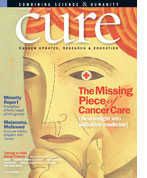Publication
Article
CURE
The High-Risk Crowd
Author(s):
Strategies for preventing cancer in people with a genetic predisposition.
When it comes to preventing cancer, everyone can benefit from exercise, not smoking, and eating a healthy diet high in fruits and vegetables. But for people with a predisposition for certain cancers, such as those with genetic mutations and a family history of cancer, prevention strategies may need to be more specific.
Chemoprevention methods, including tamoxifen, reduce the chance of breast cancer in postmenopausal women at high risk of the disease. Although tamoxifen, and now Evista (raloxifene), which was approved in September 2007 for the same indication, have been shown to prevent invasive breast cancer by up to half, women must weigh the risk of side effects, such as increased risk of endometrial cancer and stroke, with the potential cancer benefit. And while cancer incidence has been reduced, it’s not clear that mortality from the disease is lower.
Other chemoprevention methods range from aspirin for colorectal cancer to finasteride for prostate cancer, but these agents are still under investigation. The Prostate Cancer Prevention Trial, which compared finasteride with placebo in nearly 19,000 men, was stopped early in 2003 because of a clear benefit—the drug reduced the risk of prostate cancer by 25 percent. However, the study showed that among men who did develop prostate cancer, the disease was more aggressive. Finasteride is still being researched to determine the best candidates to receive the drug. Dutasteride, a second-generation drug, is also undergoing testing in prostate cancer prevention.
Prophylactic surgery, which removes tissue or an entire organ before cancer develops, can greatly lower the risk of cancer. This more drastic method is usually reserved for people with a very high risk of cancer, such as women with a family history of cancer and a BRCA mutation, which significantly increases the risk of breast and ovarian cancers. These individuals may choose to have prophylactic mastectomy and/or oophorectomy—the removal of the ovaries. Women with invasive breast cancer in one breast may choose to have both breasts removed to prevent contralateral breast cancer (when cancer develops in the second breast)—a trend that has been increasing over the past decade, according to data reported in the Journal of Clinical Oncology in late 2007.
Some people carry certain genetic mutations for colorectal cancer— hereditary nonpolyposis colorectal cancer (HNPCC) or familial adenomatous polyposis (FAP). HNPCC carries a 70 to 80 percent risk of developing the disease before age 50, with the risk of colorectal cancer reaching nearly 100 percent for people with FAP. People with these mutations often consider prophylactic removal of the colon, chemoprevention, and heightened screening.
Many individuals with a high risk of cancer choose increased screening and other non-invasive prevention methods over surgery. However, for those who undertake aggressive prevention methods, screening is still important. Tests, such as computed tomography, magnetic resonance imaging, mammography, colonoscopy, and Pap tests, among others, may need to be done frequently.






